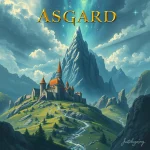
INTRODUCTION
A Substantial INFLUENCE
THE SURVIVAL From The GODS
The traditional mythological figures which have survived Christianization are rare. Following a transitional period where paganism and Christian belief were commingled, they merely survived on the amount of language: in frozen expressions and metaphors. This is the way “Odin” and “Troll” grew to become synonyms for that demon. Some figures were transformed and integrated into folk legends–the Troll grew to become a dwarf in Scandinavia and also the Shetland Islands, where it’s known as drow–but study of charms and spells reveals their persistent survival.
Throughout the 18th century, Odin grew to become the best choice from the Wild Search, once we are informed through the scholar Johann Peter Schmitt in 1742:
It’s stated particularly this more youthful Odin was an archmagician coupled with no peer within the arts of creating war. For this reason many people have searched for to determine his name Woden like a derivative of “to rage” (wüten). Further, nobody is not aware from the senseless belief held by numerous folk, especially some hunters, the time around Christmas as well as on the eve of Circus happens when the main one known as Woor or Goor or even the wild huntsman passes. They are saying the demon organizes a search having a troop of rapping spirits. When we arrive at the bottom of the superstition, we have seen it emerged in the story of the more youthful Odin, which the most popular man thinks that Odin/Wotan passes. For this reason a business of ghosts is known as the Furious Army, Eotan’s/ Odin’s Army, Gooden’s Army, or even the Army of Odin.
FOLK MYTHOLOGY
Together using the scholarly mythology, passed lower through the ancient mythographers, there’s a network of constantly evolving representations and beliefs. A picture of the distinctive world emerges out of this by which elemental and supernatural beings aren’t residents of the remote pantheon but reside in close closeness to humans–within the forests and mountain tops, underneath the gemstones, and so on. We very often discover the faded figures of high mythology here, but we find many elements that aren’t present. The majority of these creatures, that are called fantasy creatures today, carry on living in tales and legends, a resource that will not be overlooked. The job from the Grimm siblings, for instance, supplies a fine overview, using its proliferation of nixies and kobolds, ogres and giants, changelings and dwarves, as well as the main figures like Dame Holle or Holda, Percht, the Faithful Eckhart,
or even the Cursed Huntsman.
German romantic poets and authors, within the actions of Herder and also the Grimm siblings, required your hands on styles, creatures, and folk beliefs that people are now able to also see in Frédéric en Motte-Fouqué’s Undine, Adalbert de Chamisso’s Peter Schlemihl, by means of The Alder King, Lorelei, and Tannhäuser.
Encyclopedia of Norse and Germanic Folklore, Mythology, and Magic
From AAGE to ZWEIESAUGER
ABWASCHL: The “washer” is really a rapping spirit (poltergeist) from the All downhill meadows in which the herds are drawn in summer time. He adopts having these areas when the herds are taken into the valleys for that winter, washing and scraping all of the utensils left out while making this type of racket that who go by flee in terror. Sometimes he turns up to convey his irritation whenever a cowherd goes dancing without his master’s permission.
ÆGIR: Ocean giant whose name means “merman.” He offers all of the features of the ocean god. His other names are Gymir and Hler the second name are available in Hlesey, meaning “Isle of Hler” where he resides. He’s the boy of Fornjotr and also the ocean goddess Ran is his daughter or wife. He’s nine kids who’re identified using the waves. Their names are: Himinglaeva, Blodughalda, Hefring, Dufa, Udr, Hrönn, Bylgja, Bara, and Kolga.
AESIR: Among the two major groups of the Germanic pantheon, another to be the Vanir.
The Aesir contain Odin and the sons, Thor and Baldur, along with the following deities: Njördr, Freyr, Tyr, Heimdallr, Bragi, Vidar, Vali, Ullr, Hoenir, Forseti, and Loki. The Asyniur are Frigg, Freyja, Gefjon, Idunn, Gerdr, Sigyn, Fulla, Nanna, that are occasionally added Eir, Ljöfn, Lofn, Var, Vör, Syn, Hlin, Snotra, and Gna. The Aesir reside in Asgardr, and also the more essential included in this have homes whose names are recognized to us. They’re mainly from the martial function (the 2nd function based on Dumézil), but spill over in to the first (royalty/priesthood) and also the third (fertility/productiveness).
ALBERICH 1 (“Powerful Elf ”): The elf or dwarf who’s defeated by Siegfried within the Nibelungenlied (Song from the Nibelung). Alberich pads the treasure of Achilbung and Nibelung, mythical rulers whose names make reference to mist and water–and that he owns the cape of invisibility referred to as Tarnkappe (known as the cape folette in old French). Within the Norse Deed of Sigurd, he matches Andvari. He joined French letters as of Aubéron and British letters as Oberon.
ALBERICH 2 (Elberich): Within the legend from the Lombard king, Otnit, the dwarf Alberich may be the father of heroes. He’s invisible to everybody except to Ortnit, who wears a magic ring that Alberich gave to his mother. This protector dwarf provides help her boy, Otnit, who’s trying to get married the daughter from the sultan Machorel who lives
at Muntabur (Mount Thabor). He provides the king a complete suit of armor and also the sword Rose. Throughout the campaign from the infidels, Alberich plays all sorts of methods around the pagans, breaking their idols and tossing their weapons in to the castle moat. He makes fun of Machorel, who’s not able to determine him.
 Resourse: https://innertraditions.com/
Resourse: https://innertraditions.com/

